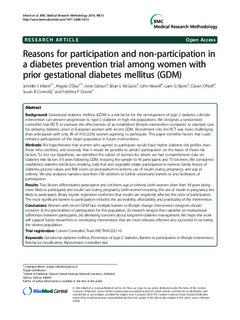| dc.contributor.author | Infanti, Jennifer | |
| dc.contributor.author | O'Dea, Angela | |
| dc.contributor.author | Gibson, Irene | |
| dc.contributor.author | McGuire, Brian E. | |
| dc.contributor.author | Newell, John | |
| dc.contributor.author | Glynn, Liam G. | |
| dc.contributor.author | O'Neill, Ciaran | |
| dc.contributor.author | Connolly, Susan B. | |
| dc.contributor.author | Dunne, Fidelma P. | |
| dc.date.accessioned | 2019-11-04T12:05:48Z | |
| dc.date.available | 2019-11-04T12:05:48Z | |
| dc.date.created | 2014-02-03T14:12:47Z | |
| dc.date.issued | 2014 | |
| dc.identifier.citation | BMC Medical Research Methodology. 2014, 14 (13), . | nb_NO |
| dc.identifier.issn | 1471-2288 | |
| dc.identifier.uri | http://hdl.handle.net/11250/2626380 | |
| dc.description.abstract | Background Gestational diabetes mellitus (GDM) is a risk factor for the development of type 2 diabetes. Lifestyle intervention can prevent progression to type 2 diabetes in high risk populations. We designed a randomised controlled trial (RCT) to evaluate the effectiveness of an established lifestyle intervention compared to standard care for delaying diabetes onset in European women with recent GDM. Recruitment into the RCT was more challenging than anticipated with only 89 of 410 (22%) women agreeing to participate. This paper identifies factors that could enhance participation of the target population in future interventions. Methods We hypothesised that women who agreed to participate would have higher diabetes risk profiles than those who declined, and secondly that it would be possible to predict participation on the bases of those risk factors. To test our hypothesis, we identified the subset of women for whom we had comprehensive data on diabetes risks factors 3-5?years following GDM, reducing the sample to 43 participants and 73 decliners. We considered established diabetes risk factors: smoking, daily fruit and vegetable intake, participation in exercise, family history of diabetes, glucose values and BMI scores on post-partum re-screens, use of insulin during pregnancy, and age at delivery. We also analysed narrative data from 156 decliners to further understand barriers to and facilitators of participation. Results Two factors differentiated participants and decliners: age at delivery (with women older than 34 years being more likely to participate) and insulin use during pregnancy (with women requiring the use of insulin in pregnancy less likely to participate). Binary logistic regression confirmed that insulin use negatively affected the odds of participation. The most significant barriers to participation included the accessibility, affordability and practicality of the intervention. Conclusions Women with recent GDM face multiple barriers to lifestyle change. Intervention designers should consider: (i) the practicalities of participation for this population, (ii) research designs that capitalise on motivational differences between participants, (iii) alleviating concerns about long-term diabetes management. We hope this work will support future researchers in developing interventions that are more relevant, effective and successful in recruiting the desired population. Trial registration Current Controlled Trials ISRCTN41202110 | nb_NO |
| dc.language.iso | eng | nb_NO |
| dc.publisher | BMC (part of Springer Nature) | nb_NO |
| dc.relation.uri | http://www.biomedcentral.com/1471-2288/14/13 | |
| dc.rights | Navngivelse 4.0 Internasjonal | * |
| dc.rights.uri | http://creativecommons.org/licenses/by/4.0/deed.no | * |
| dc.title | Reasons for participation and non-participation in a diabetes prevention trial among women with prior gestational diabetes mellitus | nb_NO |
| dc.type | Journal article | nb_NO |
| dc.type | Peer reviewed | nb_NO |
| dc.description.version | publishedVersion | nb_NO |
| dc.subject.nsi | VDP::Samfunnsvitenskap: 200 | nb_NO |
| dc.subject.nsi | VDP::Social sciences: 200 | nb_NO |
| dc.source.pagenumber | 22 | nb_NO |
| dc.source.volume | 14 | nb_NO |
| dc.source.journal | BMC Medical Research Methodology | nb_NO |
| dc.source.issue | 13 | nb_NO |
| dc.identifier.doi | 10.1186/1471-2288-14-13 | |
| dc.identifier.cristin | 1108611 | |
| dc.description.localcode | © 2014 Infanti et al.; licensee BioMed Central Ltd. This is an Open Access article distributed under the terms of the Creative Commons Attribution License (http://creativecommons.org/licenses/by/2.0), which permits unrestricted use, distribution, and reproduction in any medium, provided the original work is properly cited. The Creative Commons Public Domain Dedication waiver (http://creativecommons.org/publicdomain/zero/1.0/) applies to the data made available in this article, unless otherwise stated. | nb_NO |
| cristin.unitcode | 194,65,20,0 | |
| cristin.unitname | Institutt for samfunnsmedisin og sykepleie | |
| cristin.ispublished | true | |
| cristin.fulltext | original | |
| cristin.qualitycode | 1 | |

